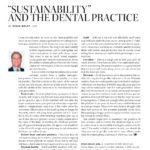Three years ago, I shifted from full time dentistry into the world of dental practice transitions. As a member of the team at ADS MidAmerica Dental Practice Sales, I’ve learned a lot about the opportunities afforded those in our profession who are just starting out, or making a mid-career course correction.
I’ve thoroughly enjoyed the opportunity to sit down with many former students and friends, sharing some of the experiences (and mistakes) I’ve made as a practice owner, while encouraging the next generation of dentists to move into private practice.
Which brings me to the subject of this post: I continue to be amazed at the disparity between dental practices in rural areas, verses those in major metros. And at the risk of appearing overly materialistic, I wanted to share a couple of observations. First, a little background.
As Dr. Wolff has pointed out numerous times, in our day – we both graduated from dental school in 1977 – most graduates had between zero and $15,000 in debt. We enjoyed great careers where we wanted to be. Many of us have been taking home between $100,000 and $200,000 per year, and are now seriously thinking about retirement.
Contrast the new graduate, with $250,000.00 in debt, who needs to generate much more income than the previous generation. In fact, if you do the math, that new dentist has to commit the first $100,000 of production to making his annual student loan payment before taking any money home to pay the mortgage, keep the lights on, or save for kids’ college.
So now, my thoughts on (relatively) smaller-market practices. Our office is consistently seeing practices grossing up to a million dollars, and taking home from $300- $400,000.00. What do these offices have in common? Glad you asked. They are in rural areas, or at least in areas not named Kansas City. In recent months, we listed five practices in the Wichita area, and while Wichita is definitely not a rural environment, the opportunity for income significantly above what I see as a typical Kansas City area practice is undeniable.
(Speaking of Wichita; without checking Siri, what would you venture to be the population of Wichita? Well, it’s 644,610. They’ve got arenas, excellent shopping, universities, and private golf clubs I can’t afford. It’s a great city. Quite the place, actually.)
In smaller communities – the earning potential for a dentist in western Kansas, southern or central Missouri can easily be THREE TIMES what a typical 55-year-old dentist in Overland Park or Lee’s Summit is taking home. Yes. You read that right. Three times. Worth considering?
So what’s the take away? I’m hoping that some small percentage of you who are now in dental school, or who are just beginning your career working at a Federally Qualified Health Center or a corporate dental practice will consider a future you hadn’t thought of before. A future that would give you some life style choices – and potentially a lot more income.
I mentioned before that the real reward for my personal career change has been sitting down with dentists and discussing the opportunities and options, seen from the eyes of a baby boomer who has benefitted greatly from what this profession has to offer. Give me a call. I’ll buy the coffee.
Brad Babcock, DDS
 [Note – those of you who are readers of Dental Economics magazine will recognize Dr. Wolff’s November, 2013 article from that magazine. Click here to download a PDF.
[Note – those of you who are readers of Dental Economics magazine will recognize Dr. Wolff’s November, 2013 article from that magazine. Click here to download a PDF.



